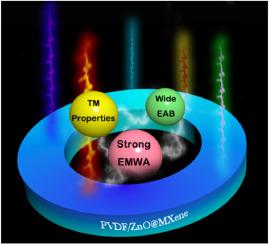Heterojunction engineering of large-sized Ti3C2Tx MXene with ZnO for enhanced high-frequency microwave absorption and thermal conductivity
IF 9.8
1区 材料科学
Q1 MATERIALS SCIENCE, COMPOSITES
引用次数: 0
Abstract
Polymer composites with superior electromagnetic wave (EMW) absorption properties, such as strong attenuation and broadband absorption, as well as excellent thermal conductivity, are ideal for the preparation of high-frequency, high-power electronic devices. Hence, we designed ZnO/Ti3C2Tx MXene heterostructured nanofillers by loading surface-modified ZnO nanoparticles onto large-sized Ti3C2Tx MXene nanolayers using electrostatic interactions. Subsequently, PVDF/ZnO/Ti3C2Tx MXene (PZM) composites were prepared by blending and hot-press molding process with polyvinylidene difluoride (PVDF) resin. By optimizing the doping ratio of ZnO to Ti3C2Tx MXene in heterogeneous interface engineering, the high-frequency microwave absorption and thermal conductivity of the composites were precisely tuned. When the mass ratio of ZnO to Ti3C2Tx MXene is 3:2 (PZM-3), PZM shows the best attenuation of electromagnetic waves, with a minimum reflection loss of −47.2 dB at a thickness of only 2.5 mm, and an effective absorption bandwidth of 4.2 GHz (11.12–15.32 GHz). This bandwidth covers almost all operating band of high-frequency microwave communication equipment up to 18 GHz. Meanwhile, its thermal conductivity increases by 120 % compared to pristine PVDF resin. Most surprisingly, when the mass ratio of ZnO to Ti3C2Tx MXene is 2:3 (PZM-4), the PZM composites exhibit the best thermal conductivity, which increases by 555 %. Furthermore, radar cross section (RCS) was used to simulate the EMW absorption characteristics of PZM composites in practical application scenarios, confirming that PZM composites have a strong EMW loss capability. This work provides a new path for practical application and deep expansion in the field of efficient microwave absorption and thermal management in complex frequency bands, especially in the high-frequency domain.

大尺寸Ti3C2Tx MXene的ZnO异质结工程,增强高频微波吸收和导热性
聚合物复合材料具有优异的电磁波(EMW)吸收性能,如强衰减和宽带吸收,以及优异的导热性,是制备高频、大功率电子器件的理想选择。因此,我们设计了ZnO/Ti3C2Tx MXene异质结构纳米填料,通过静电相互作用将表面修饰的ZnO纳米颗粒加载到大尺寸Ti3C2Tx MXene纳米层上。随后,采用聚偏氟乙烯(PVDF)树脂共混和热压成型工艺制备了PVDF/ZnO/Ti3C2Tx MXene (PZM)复合材料。通过在非均相界面工程中优化ZnO与Ti3C2Tx MXene的掺杂比例,可以精确调节复合材料的高频微波吸收和导热系数。当ZnO与Ti3C2Tx MXene的质量比为3:2 (PZM-3)时,PZM对电磁波的衰减效果最好,在厚度仅为2.5 mm时,反射损耗最小为- 47.2 dB,有效吸收带宽为4.2 GHz (11.12-15.32 GHz)。该带宽几乎覆盖了18ghz以下高频微波通信设备的所有工作频段。同时,与原始PVDF树脂相比,其导热系数提高了120%。最令人惊讶的是,当ZnO与Ti3C2Tx MXene的质量比为2:3 (PZM-4)时,PZM复合材料的导热性最好,提高了555%。利用雷达截面(RCS)模拟了PZM复合材料在实际应用场景下的EMW吸收特性,证实了PZM复合材料具有较强的EMW损耗能力。本工作为复杂频段特别是高频频段的高效微波吸收和热管理领域的实际应用和深入拓展提供了新的途径。
本文章由计算机程序翻译,如有差异,请以英文原文为准。
求助全文
约1分钟内获得全文
求助全文
来源期刊

Composites Science and Technology
工程技术-材料科学:复合
CiteScore
16.20
自引率
9.90%
发文量
611
审稿时长
33 days
期刊介绍:
Composites Science and Technology publishes refereed original articles on the fundamental and applied science of engineering composites. The focus of this journal is on polymeric matrix composites with reinforcements/fillers ranging from nano- to macro-scale. CSTE encourages manuscripts reporting unique, innovative contributions to the physics, chemistry, materials science and applied mechanics aspects of advanced composites.
Besides traditional fiber reinforced composites, novel composites with significant potential for engineering applications are encouraged.
 求助内容:
求助内容: 应助结果提醒方式:
应助结果提醒方式:


